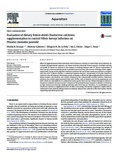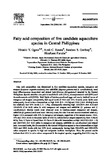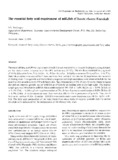| dc.contributor.author | Ludevese-Pascual, Gladys | |
| dc.contributor.author | Laranja, Joseph Leopoldo | |
| dc.contributor.author | Ahmed, Farhana | |
| dc.contributor.author | Amar, Edgar | |
| dc.contributor.author | De Troch, Marleen | |
| dc.contributor.author | Bossier, Peter | |
| dc.contributor.author | De Schryver, Peter | |
| dc.date.accessioned | 2021-02-04T08:23:18Z | |
| dc.date.available | 2021-02-04T08:23:18Z | |
| dc.date.issued | 2020-12 | |
| dc.identifier.citation | Ludevese-Pascual, G., Laranja, J. L., Ahmed, F., Amar, E., De Troch, M., Bossier, P., & De Schryver, P. (2020). Lipids and fatty acid composition in the crustacean model organism Artemia sp. as influenced by poly‐β‐hydroxybutyrate (PHB) supplementation. Aquaculture Nutrition, 26(6), 2235-2244. | en |
| dc.identifier.issn | 1353-5773 | |
| dc.identifier.uri | http://hdl.handle.net/10862/6028 | |
| dc.description.abstract | The effects of dietary poly-β-hydroxybutyrate (PHB) on the lipid and fatty acids (FA) in crustaceans were investigated using Artemia as model species. Supplying PHB either in crystalline or amorphous form significantly increased the whole-body lipid contents of starved Artemia. Co-supplying dietary PHB with bacterial PHB degrader Comamonas testosteroni at 106 cells ml−1 for 24 hr also significantly increased this parameter. These findings have important implications on the lipid-saving effects of PHB in crustacean tissues. Dietary PHB, however, did not contribute to the increase in docosahexaenoic acid (DHA) of the naturally DHA-deprived Artemia. Alternative strategy of co-supplying dietary PHB with highly unsaturated fatty acid (HUFA)-rich emulsion for 24 hr effectively improved the nutritional contents of Artemia and at the same time assured efficient delivery of PHB to the larval predator. According to a 13C stable isotope tracer study, the significantly higher δ13C levels measured in Artemia 2 hr postfeeding with 13C-labelled R. eutropha DSM545 indicate that PHB offered in natural matrix is rapidly assimilated. Overall, this study demonstrated the lipid-saving effects of PHB in Artemia. PHB assimilation following gastrointestinal degradation could attribute to its reported beneficial effects in various aquatic farmed species. | en |
| dc.language.iso | en | en |
| dc.publisher | Wiley | en |
| dc.subject | Artemia | en |
| dc.subject | Lipid emulsion | en |
| dc.subject | poly‐β‐hydroxybutyrate (PHB) | en |
| dc.subject | docosahexaenoic acid | en |
| dc.subject | Artemia nauplii | en |
| dc.title | Lipids and fatty acid composition in the crustacean model organism Artemia sp. as influenced by poly‐β‐hydroxybutyrate (PHB) supplementation | en |
| dc.type | Article | en |
| dc.citation.volume | 26 | |
| dc.citation.issue | 6 | |
| dc.citation.spage | 2235 | |
| dc.citation.epage | 2244 | |
| dc.citation.journalTitle | Aquaculture Nutrition | en |
| dc.subject.asfa | fatty acids | en |
| dc.subject.asfa | lipids | en |
| dc.subject.asfa | marine crustaceans | en |
| dc.subject.asfa | brine shrimp culture | en |
| dc.subject.asfa | axenic culture | en |
| dc.subject.asfa | algal culture | en |
| dc.identifier.essn | 1365-2095 | |
| dc.identifier.doi | 10.1111/anu.13160 | |
| dc.subject.scientificName | Comamonas testosteroni | en |
| dc.subject.scientificName | Ralstonia eutropha | en |



